Back to basics: overview of the most affordable mouse from Razer
The transition from the “ordinary” periphery to the “premium” one happens differently for everyone. Someone is presented with a cool mouse or keyboard, after which a person understands which device he used before, and is captured by mechanical switches, precise sensors and powerful software for setting up everything. Someone comes into this world on their own, realizing that with his current mouse it’s difficult to get to the right pixel in Photoshop, and in games the scope is trembling, as if the player is in the midst of an earthquake.
One way or another, everyone has to start somewhere: to buy an expensive mouse for 10-12 thousand rubles after having been using some Genius for 300-500 all his life does not always seem like a reasonable move. Today we’ll take a closer look at the youngest mouse in the Razer line: the 2014 Abyssus model in Essential Edition.

The “gaming” mouse differs from the usual one primarily in three things: the hardware component (a sensor, a chip that processes data from optics, special microswitches that allow you to register button clicks), software (special drivers and software), and ergonomics. Of course, besides this, designers are perverted in every way to make the product not only convenient, but also attractive; but they’re always busy with it - both in gaming products and in non-gaming products.
The following parameters allow us to judge the mouse’s ability to move the cursor :
Optical resolution of the sensor (measured in CPI / DPI). The higher it is, the smaller the change in the position of the mouse can be detected by the sensor, the more accurately the cursor moves (with certain corrections, of course) and the more data is transmitted with every millimeter that the mouse passes.
Sensor polling rate . This value became relevant with the transition of mice and keyboards to the USB port: the previous connection port (PS / 2) received interrupts from the periphery itself, while the system interrogates the USB bus. The higher the polling frequency, the more often the OS receives information about the cursor movements, the “faster” the response is, and the more accurately the cursor moves after the mouse moves.
Type of sensor . The vast majority of current mice use an optical sensor: with LED backlight, or with a laser. The first option is cheaper, the second one is more expensive and more precisely. There are a lot of options for these same sensors, both inexpensive and very accurate, but also worth accordingly. The coolest mice are equipped with a 4th generation dual optical sensor with laser illumination.
Lift off. In Russian, this thing is called the "separation height" - the amount by which you need to raise the mouse above the surface so that it ceases to register movements. On the one hand, it may seem that the smaller the characteristic, the better, but here other forces come into play: the user's habit, the features of the carpet / surface, the style of working with the mouse. For the best options for gaming mice, the parameter is configured within a fairly wide range.
Other characteristics, such as maximum speed and maximum acceleration are not so important today. It is unlikely that you can accelerate the mouse to 15 g or accelerate to two meters per second to rest against the capabilities of modern sensors. Unless, of course, do not play on a professional level. And if you play, and already rested - probably the mouse has long been changed to some DeathAdder or Mamba.
Abyssus (in the Razer classification) refers to “entry-level” gaming mice: there is nothing superfluous in the design, no super-bells and whistles, just a mouse that performs one function: it moves the cursor perfectly. Here are brief characteristics of the rodent:
Model: Razer Abyssus 2014 Essential Edition;
Connection: Wired, USB 2.0;
Design: Symmetrical, "intermediate" grip;
Weight: 82 grams;
Number of buttons: 3 + scroll wheel;
Guaranteed resource: up to 5 million clicks, more than 100 million “lines” of scrolling;
Sensor Type: Laser, 3.5 generations;
Sensor Resolution: 100-3500 DPI;
Sensor Model: Avago ADNS-3888;
Sensor polling frequency: 125/500/1000 Hz;
Firmware support: Razer Synapse 2.0.
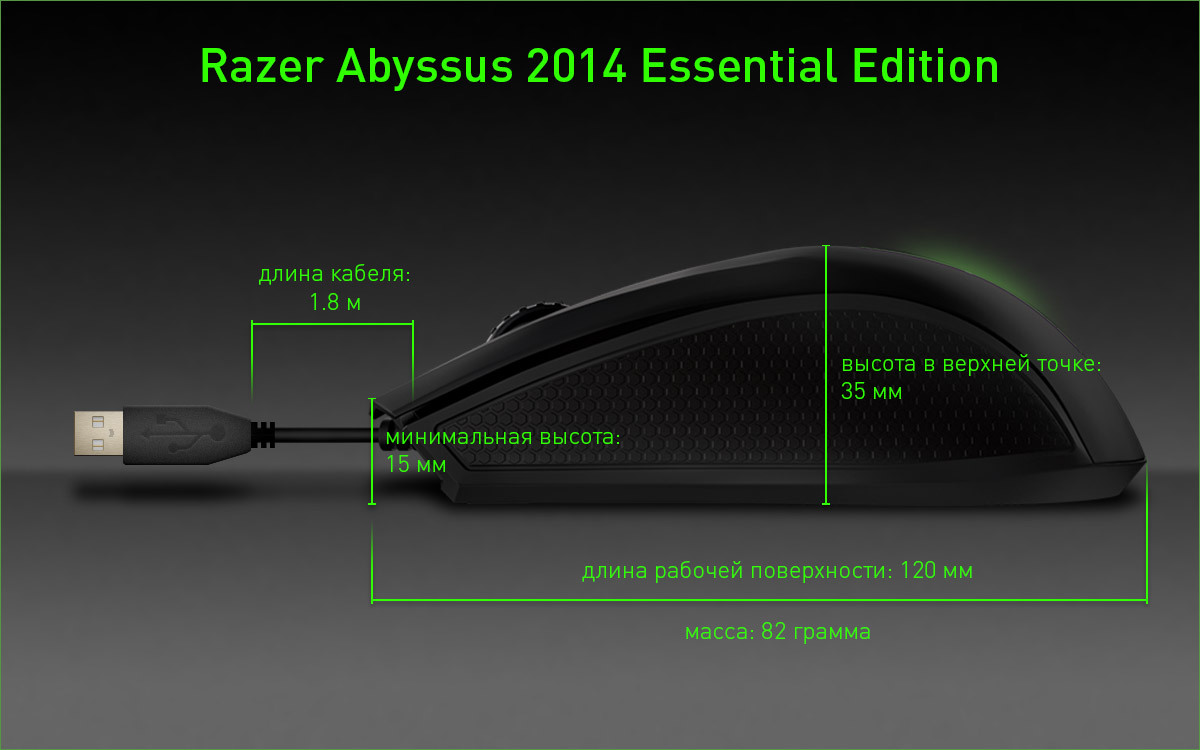
In this case, Razer applied the established formula: take what works well, remove all unnecessary, wrap it up nicely and sell it to satisfied users.
As I already wrote, the mouse is made in the style of "nothing more"; in addition, it belongs to the line of symmetrical mice: that is, it is equally suitable for left-handed people, and right-handed people, and those people who do not like curved ergonomic mice (although how can you not like them ?!).

Housing materials are typical for Razer products designed in 2014: softtouch plastic and glossy elements gave way to a practical matte finish: it does not peel, does not get dirty, does not get covered with small scratches.

The rubber inserts on the sides are made of inexpensive, but high-quality material: it does not collect dirt, dust, fingerprints, while it does not slip and does not wear. In a similar way, the wheel has also changed: a harder and more wear-resistant rubber with a redesigned notches is used.

In general, given the clearly limited production budget, it came out very, very badly and with a clear eye on the long service life of such a device. It's nice that Razer is aware that entry-level products are taken by those who are not ready to change peripherals every year or two, and have sharpened their accessible mouse accordingly. As for the design, I like the overall style, although I prefer larger mice.

The box, by the way, has become more modest. Here in such a bright package the past Abyssus were sold (in the photo the Mirror version is made of glossy plastic):

And here is the 2014 design:


To call a mouse a small language does not turn. Great, however, too. So the mouse grip is stuck exactly between the “finger” when you move it, squeezing the body with your fingers on the sides and the “palm” (moving in which is done with the entire brush lying on the mouse body).
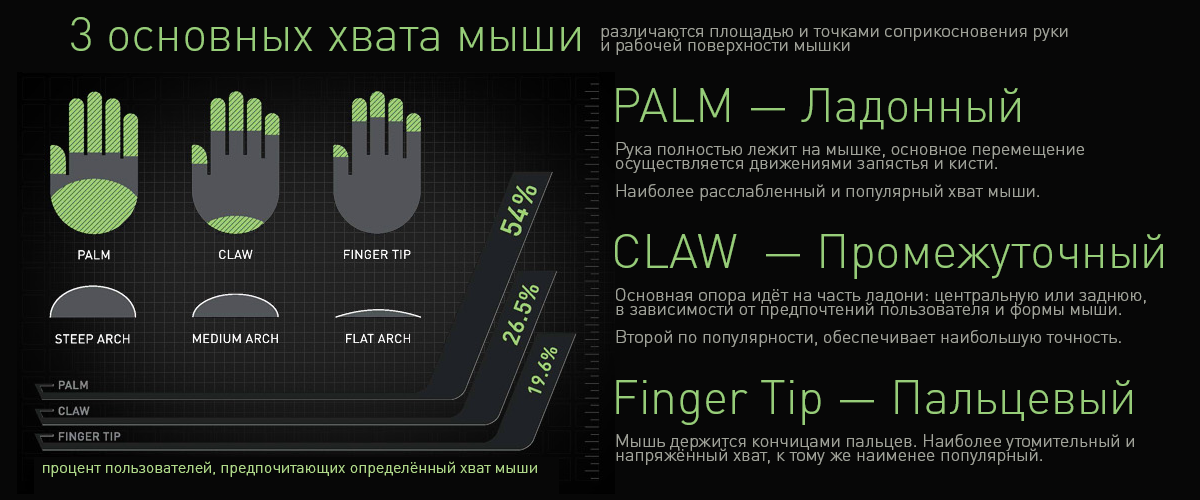
A sufficiently short “rear overhang” and a curved back allow you to fit ⅔ of the average palm, but the wrist and the adjacent part of the palm will crawl along the table or carpet.
The Razer mouse, first of all, is not only avaluable fur of high-quality hardware, but also sensible software. With the transition to the unified platform Synapse 2.0, all new products work with a cloud interface.
I have almost no complaints about Synapse itself, as a control panel: all the necessary functions are present in full (and we will talk about them a bit later), the interface is simple, like elevator doors, everything works as you expect. The disadvantages lie in another area: in pursuit of features and near-game functionality, the guys from Razer simply forgot that software should be tested on real people.
For example, after connecting a new device (for example, you already have a Razer keyboard and you bought a mouse), the system will offer to download the update, and then request a reboot. You can ignore the request, run Synapse from the Start menu again, and everything will work - but why then ask for a reboot? Just in case? After all, you can issue a window with the text "if your device does not appear in the Razer Synapse control panel - restart your computer."
Each time you reboot the system, Razer Synapse may offer synchronization with the cloud: a desync of the system clock over time on the servers in a few seconds is unlikely to lead to a fatal loss of the profiles that you set up for a good forty minutes, but the user’s attention is distracting.
All these little things can and should be debugged for a long time, corrected, made the maintenance software completely invisible until it is needed - but what is, that is. But there are no complaints about the functions and capabilities of the software. Here is what Synapse can do in conjunction with Razer Abyssus:
Firstly, the mouse settings are available: reassignment of all mouse buttons (I have no idea why remap LMB and RMB, but suddenly who needs it?), And with reference to profiles that can be associated with any application.
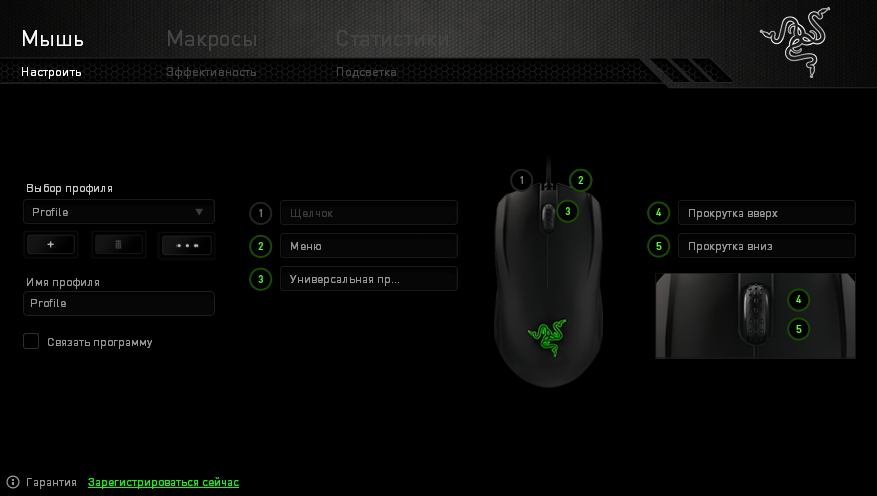
In addition, you can adjust the sensitivity of the sensor, the polling frequency, cursor acceleration - and in the same way bind settings to applications. If you have a good carpet, I would recommend setting the maximum sensitivity and reducing the speed of moving the cursor in the system settings to a comfortable level: this way you will increase the accuracy of moving the cursor, and you won’t suffer from its insane sensitivity.
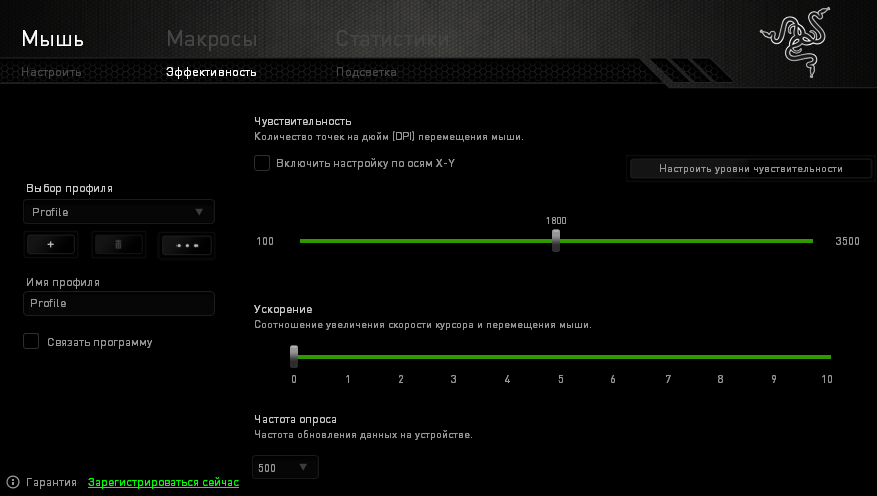
The mouse supports separate control of sensitivity along the X and Y axes (where it is not very necessary, but sometimes required) and the creation of several sensitivity levels within the same profile. True, in order to use them normally (that is, switch them), you will need to assign some button to this function, and Abyssus does not have any extra buttons at all, so the main candidate for reassignment is the click wheel.

Regarding separate sensitivity for two axes: I am often asked where this can be applied. The only application I know of such a feature is scopeing: shooting in rifle games with a telescopic sight. At the moment when you made the initial guidance, one of the buttons responsible for temporarily activating the reduced sensitivity is clamped (usually ½ from the "normal" in the X axis and ¼-⅛ in the Y axis) and the cursor is "brought" to the target.

Thus, it is easier to lead the target in a wide motion along the horizontal axis. This feature is not often used, it requires habit, and on Abyssus it also leads to the loss of SCM or scroll, since, again, there are no extra buttons.
The second feature of proprietary software is macro recording. It is maintained in a simple and intuitive interface, I have not found any restrictions on the length of the macros or their number.
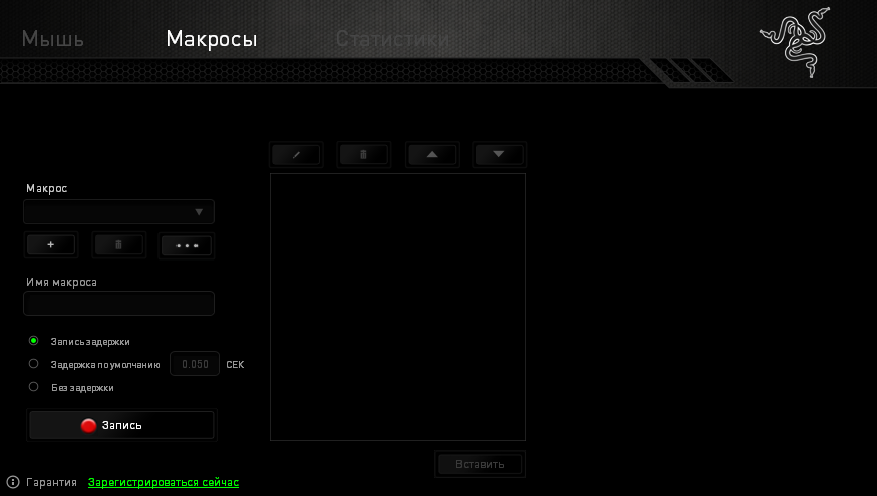
The interface is very simple and clear: clicked “+”, entered the macro name, clicked “record”, enter the desired sequence of characters from the keyboard / click with the mouse buttons.

If you want to do something faster than you can with your hands, you can turn on the automatic replacement of delays by, say, 0.050 seconds. As a result, “All your base are belong to us” and “You have no chance to survive make your time” will be sent to the game chat from one button, and in less than a second.
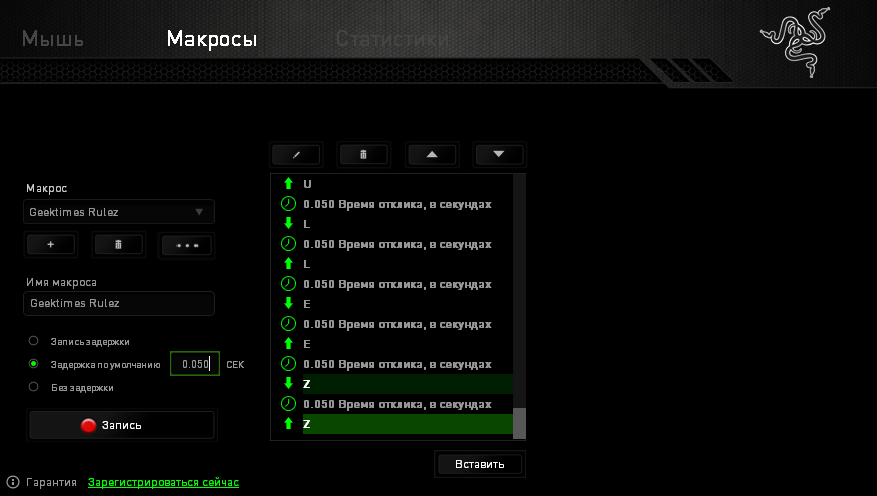
In addition, the software allows you to configure (enable or disable) the logo backlight on the mouse. Not the most necessary feature, but suddenly you are annoyed by luminous gadgets? :) In addition, here you can set one very important tick: if your motherboard continues to supply voltage to the ports to which Razer devices are connected, even when the computer is sleeping, you can ask the driver to turn off the backlight when the display is off! Must Have!
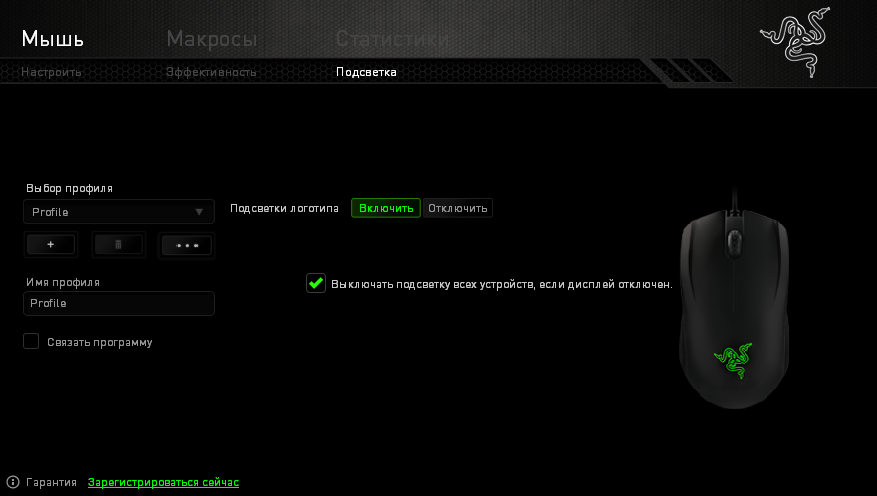
Unfortunately, the mouse is deprived of sensor calibration settings for the working surface, adjustable lift-offs and various other little things available to more expensive models. Fortunately, this is compensated by well-chosen characteristics and settings “out of the box”.
But the feature for collecting statistics has not gone away:

You can study your runs, clicks, and any other in-device kitchen for a very long time. In addition, you can get records of the click map (both within specific applications, and for the whole time of accumulating information) and the intensity of cursor movement.

Not to say that the most necessary information, but it is present and easily retrieved.
Close communication with the mouse over the course of two weeks revealed the following advantages and disadvantages: The
mouse is very light, which affects both the speed of its movement and almost zero inertia, and the absence of fatigue even after several hours of the most intense gameplay that you can afford.
The sensor itself (Avago ADNS-3888, the same one was used in 2012-2013 DeathAdder mice, if my memory serves me) is not satisfactory, but its setup ... Let's just say that it made it more accurate, comparable (but not similar!)with the top mice of past years, but also more moody. The mouse perfectly digests my carpets (Razer ExactMate, Destructor, Sphex), but some cheap veneer with a texture inexpressive to the sensor can confuse the system. In the best case, the cursor will simply move no better than with a 200-ruble noname mouse, in the worst case it simply will not budge.
The mouse ceases to track the surface when detached by about 2.5 millimeters. To my taste, a bit too much, but I rarely use the mouse swap and do not suffer from this effect in any way. In general, the result is decent.
Some Abyssus users complain that the mouse "shakes" at maximum sensitivity. Razer posted the solution to this problem on the official website. It is enough to update the firmware of the mouse (through proprietary software), and all the tremor will disappear.
According to the manufacturer on the box, Abyssus is a return to the basics. In some ways, I agree. The mouse is built on the principle of "nothing more": two buttons, a wheel, a huge resource and safety margin. The question is only to the Teflon feet - they, traditionally, are not very tenacious, and they do not put spare parts in the kit for Abyss. :( However, spare parts can always be purchased on the official website. In games, the device behaves more than worthily: it’s easy and pleasant to catch “frags”, send troops into battle and commit other indecencies.

And so what, and to compare the gameplay even on such an inexpensive mouse with any "non-gaming" language just does not turn. It's like trying to compare modern cars with rally cars from the 80s. Yes, perhaps they did not have high technology, beautiful dashboard lighting, music and a bunch of smart electronics. However, many of the achievements of Group B have not yet been beaten. Yes, your office mouse may have 10 buttons more, 8 backlight colors, a built-in vibromotor and a USB hub for 4 ports, but this is unlikely to help in games and serious applications. :)
By the way, the mouse is suitable not only for players: many friends who work with graphics (both two-dimensional and three-dimensional) have very cool mice (and carpets), and I understand them very well: it's difficult to create pixel-perfect images when you can’t move the cursor exactly one point to the left or right, without resorting to magnification. So, if you work with graphics, photographs, three-dimensional models or all kinds of CAD systems, regularly fight with a naughty cursor and beat the tenth “Janius” in a year - maybe stop chewing a cactus? :)
The only significant drawback of this model is the lack of additional buttons (at least one) - a direct consequence of the relatively low (dollar) price of a product of this level.
A mouse is a mouse. Someone lacks a simple one, someone buys the crazy Mamba and Ouroboros , but someone just has not yet passed through the “point of no return” to consumer goods. It was for such users that Abyssus was created. Plain. Accurate. Easy. Available.
Pros and cons:
+ Fairly accurate sensor;
+ Pleasant software;
+ Good settings "out of the box";
+ Neutral body shape, suitable for both left-handed and right-handed people;
+ Quality materials;
+ PRICE, both in dollars and in rubles ;
- Only three buttons and a wheel;
- Naughty behavior on the tables, a carpet is often required;
- Some instances require a firmware update;
That's all. Use high-quality peripherals, shoot accurately, give orders quickly, work comfortably and may there be a plus in karma with you. :)

Our previous reviews:
» Nikon 1 S2: one-button mirrorless
» Lenovo Miix 3-1030 review
» Understanding the Wacom art-chaos
» ASUS ZenFone 5, LG L90, HTC Desire 601 - dual-sim consumer war, part 1
» ASUS Transformer Pad
» Razer Kraken Headsets
» Midland GXT-1050 Radios
» NVIDIA SHIELD Game Console

The “gaming” mouse differs from the usual one primarily in three things: the hardware component (a sensor, a chip that processes data from optics, special microswitches that allow you to register button clicks), software (special drivers and software), and ergonomics. Of course, besides this, designers are perverted in every way to make the product not only convenient, but also attractive; but they’re always busy with it - both in gaming products and in non-gaming products.
Important Features
The following parameters allow us to judge the mouse’s ability to move the cursor :
Optical resolution of the sensor (measured in CPI / DPI). The higher it is, the smaller the change in the position of the mouse can be detected by the sensor, the more accurately the cursor moves (with certain corrections, of course) and the more data is transmitted with every millimeter that the mouse passes.
Sensor polling rate . This value became relevant with the transition of mice and keyboards to the USB port: the previous connection port (PS / 2) received interrupts from the periphery itself, while the system interrogates the USB bus. The higher the polling frequency, the more often the OS receives information about the cursor movements, the “faster” the response is, and the more accurately the cursor moves after the mouse moves.
Type of sensor . The vast majority of current mice use an optical sensor: with LED backlight, or with a laser. The first option is cheaper, the second one is more expensive and more precisely. There are a lot of options for these same sensors, both inexpensive and very accurate, but also worth accordingly. The coolest mice are equipped with a 4th generation dual optical sensor with laser illumination.
Lift off. In Russian, this thing is called the "separation height" - the amount by which you need to raise the mouse above the surface so that it ceases to register movements. On the one hand, it may seem that the smaller the characteristic, the better, but here other forces come into play: the user's habit, the features of the carpet / surface, the style of working with the mouse. For the best options for gaming mice, the parameter is configured within a fairly wide range.
Other characteristics, such as maximum speed and maximum acceleration are not so important today. It is unlikely that you can accelerate the mouse to 15 g or accelerate to two meters per second to rest against the capabilities of modern sensors. Unless, of course, do not play on a professional level. And if you play, and already rested - probably the mouse has long been changed to some DeathAdder or Mamba.
Razer abyssus
Abyssus (in the Razer classification) refers to “entry-level” gaming mice: there is nothing superfluous in the design, no super-bells and whistles, just a mouse that performs one function: it moves the cursor perfectly. Here are brief characteristics of the rodent:
Model: Razer Abyssus 2014 Essential Edition;
Connection: Wired, USB 2.0;
Design: Symmetrical, "intermediate" grip;
Weight: 82 grams;
Number of buttons: 3 + scroll wheel;
Guaranteed resource: up to 5 million clicks, more than 100 million “lines” of scrolling;
Sensor Type: Laser, 3.5 generations;
Sensor Resolution: 100-3500 DPI;
Sensor Model: Avago ADNS-3888;
Sensor polling frequency: 125/500/1000 Hz;
Firmware support: Razer Synapse 2.0.

In this case, Razer applied the established formula: take what works well, remove all unnecessary, wrap it up nicely and sell it to satisfied users.
Appearance and usability
As I already wrote, the mouse is made in the style of "nothing more"; in addition, it belongs to the line of symmetrical mice: that is, it is equally suitable for left-handed people, and right-handed people, and those people who do not like curved ergonomic mice (although how can you not like them ?!).

Housing materials are typical for Razer products designed in 2014: softtouch plastic and glossy elements gave way to a practical matte finish: it does not peel, does not get dirty, does not get covered with small scratches.

The rubber inserts on the sides are made of inexpensive, but high-quality material: it does not collect dirt, dust, fingerprints, while it does not slip and does not wear. In a similar way, the wheel has also changed: a harder and more wear-resistant rubber with a redesigned notches is used.

In general, given the clearly limited production budget, it came out very, very badly and with a clear eye on the long service life of such a device. It's nice that Razer is aware that entry-level products are taken by those who are not ready to change peripherals every year or two, and have sharpened their accessible mouse accordingly. As for the design, I like the overall style, although I prefer larger mice.

The box, by the way, has become more modest. Here in such a bright package the past Abyssus were sold (in the photo the Mirror version is made of glossy plastic):

And here is the 2014 design:


Grab
To call a mouse a small language does not turn. Great, however, too. So the mouse grip is stuck exactly between the “finger” when you move it, squeezing the body with your fingers on the sides and the “palm” (moving in which is done with the entire brush lying on the mouse body).

A sufficiently short “rear overhang” and a curved back allow you to fit ⅔ of the average palm, but the wrist and the adjacent part of the palm will crawl along the table or carpet.
Software
The Razer mouse, first of all, is not only a
I have almost no complaints about Synapse itself, as a control panel: all the necessary functions are present in full (and we will talk about them a bit later), the interface is simple, like elevator doors, everything works as you expect. The disadvantages lie in another area: in pursuit of features and near-game functionality, the guys from Razer simply forgot that software should be tested on real people.
For example, after connecting a new device (for example, you already have a Razer keyboard and you bought a mouse), the system will offer to download the update, and then request a reboot. You can ignore the request, run Synapse from the Start menu again, and everything will work - but why then ask for a reboot? Just in case? After all, you can issue a window with the text "if your device does not appear in the Razer Synapse control panel - restart your computer."
Each time you reboot the system, Razer Synapse may offer synchronization with the cloud: a desync of the system clock over time on the servers in a few seconds is unlikely to lead to a fatal loss of the profiles that you set up for a good forty minutes, but the user’s attention is distracting.
All these little things can and should be debugged for a long time, corrected, made the maintenance software completely invisible until it is needed - but what is, that is. But there are no complaints about the functions and capabilities of the software. Here is what Synapse can do in conjunction with Razer Abyssus:
Firstly, the mouse settings are available: reassignment of all mouse buttons (I have no idea why remap LMB and RMB, but suddenly who needs it?), And with reference to profiles that can be associated with any application.

In addition, you can adjust the sensitivity of the sensor, the polling frequency, cursor acceleration - and in the same way bind settings to applications. If you have a good carpet, I would recommend setting the maximum sensitivity and reducing the speed of moving the cursor in the system settings to a comfortable level: this way you will increase the accuracy of moving the cursor, and you won’t suffer from its insane sensitivity.

The mouse supports separate control of sensitivity along the X and Y axes (where it is not very necessary, but sometimes required) and the creation of several sensitivity levels within the same profile. True, in order to use them normally (that is, switch them), you will need to assign some button to this function, and Abyssus does not have any extra buttons at all, so the main candidate for reassignment is the click wheel.

Regarding separate sensitivity for two axes: I am often asked where this can be applied. The only application I know of such a feature is scopeing: shooting in rifle games with a telescopic sight. At the moment when you made the initial guidance, one of the buttons responsible for temporarily activating the reduced sensitivity is clamped (usually ½ from the "normal" in the X axis and ¼-⅛ in the Y axis) and the cursor is "brought" to the target.

Thus, it is easier to lead the target in a wide motion along the horizontal axis. This feature is not often used, it requires habit, and on Abyssus it also leads to the loss of SCM or scroll, since, again, there are no extra buttons.
The second feature of proprietary software is macro recording. It is maintained in a simple and intuitive interface, I have not found any restrictions on the length of the macros or their number.

The interface is very simple and clear: clicked “+”, entered the macro name, clicked “record”, enter the desired sequence of characters from the keyboard / click with the mouse buttons.

If you want to do something faster than you can with your hands, you can turn on the automatic replacement of delays by, say, 0.050 seconds. As a result, “All your base are belong to us” and “You have no chance to survive make your time” will be sent to the game chat from one button, and in less than a second.

In addition, the software allows you to configure (enable or disable) the logo backlight on the mouse. Not the most necessary feature, but suddenly you are annoyed by luminous gadgets? :) In addition, here you can set one very important tick: if your motherboard continues to supply voltage to the ports to which Razer devices are connected, even when the computer is sleeping, you can ask the driver to turn off the backlight when the display is off! Must Have!

Unfortunately, the mouse is deprived of sensor calibration settings for the working surface, adjustable lift-offs and various other little things available to more expensive models. Fortunately, this is compensated by well-chosen characteristics and settings “out of the box”.
But the feature for collecting statistics has not gone away:

You can study your runs, clicks, and any other in-device kitchen for a very long time. In addition, you can get records of the click map (both within specific applications, and for the whole time of accumulating information) and the intensity of cursor movement.

Not to say that the most necessary information, but it is present and easily retrieved.
In work
Close communication with the mouse over the course of two weeks revealed the following advantages and disadvantages: The
mouse is very light, which affects both the speed of its movement and almost zero inertia, and the absence of fatigue even after several hours of the most intense gameplay that you can afford.
The sensor itself (Avago ADNS-3888, the same one was used in 2012-2013 DeathAdder mice, if my memory serves me) is not satisfactory, but its setup ... Let's just say that it made it more accurate, comparable (but not similar!)with the top mice of past years, but also more moody. The mouse perfectly digests my carpets (Razer ExactMate, Destructor, Sphex), but some cheap veneer with a texture inexpressive to the sensor can confuse the system. In the best case, the cursor will simply move no better than with a 200-ruble noname mouse, in the worst case it simply will not budge.
The mouse ceases to track the surface when detached by about 2.5 millimeters. To my taste, a bit too much, but I rarely use the mouse swap and do not suffer from this effect in any way. In general, the result is decent.
Some Abyssus users complain that the mouse "shakes" at maximum sensitivity. Razer posted the solution to this problem on the official website. It is enough to update the firmware of the mouse (through proprietary software), and all the tremor will disappear.
Overall: back to basics
According to the manufacturer on the box, Abyssus is a return to the basics. In some ways, I agree. The mouse is built on the principle of "nothing more": two buttons, a wheel, a huge resource and safety margin. The question is only to the Teflon feet - they, traditionally, are not very tenacious, and they do not put spare parts in the kit for Abyss. :( However, spare parts can always be purchased on the official website. In games, the device behaves more than worthily: it’s easy and pleasant to catch “frags”, send troops into battle and commit other indecencies.

And so what, and to compare the gameplay even on such an inexpensive mouse with any "non-gaming" language just does not turn. It's like trying to compare modern cars with rally cars from the 80s. Yes, perhaps they did not have high technology, beautiful dashboard lighting, music and a bunch of smart electronics. However, many of the achievements of Group B have not yet been beaten. Yes, your office mouse may have 10 buttons more, 8 backlight colors, a built-in vibromotor and a USB hub for 4 ports, but this is unlikely to help in games and serious applications. :)
By the way, the mouse is suitable not only for players: many friends who work with graphics (both two-dimensional and three-dimensional) have very cool mice (and carpets), and I understand them very well: it's difficult to create pixel-perfect images when you can’t move the cursor exactly one point to the left or right, without resorting to magnification. So, if you work with graphics, photographs, three-dimensional models or all kinds of CAD systems, regularly fight with a naughty cursor and beat the tenth “Janius” in a year - maybe stop chewing a cactus? :)
The only significant drawback of this model is the lack of additional buttons (at least one) - a direct consequence of the relatively low (dollar) price of a product of this level.
Summary
A mouse is a mouse. Someone lacks a simple one, someone buys the crazy Mamba and Ouroboros , but someone just has not yet passed through the “point of no return” to consumer goods. It was for such users that Abyssus was created. Plain. Accurate. Easy. Available.
Pros and cons:
+ Fairly accurate sensor;
+ Pleasant software;
+ Good settings "out of the box";
+ Neutral body shape, suitable for both left-handed and right-handed people;
+ Quality materials;
+ PRICE, both in dollars and in rubles ;
- Only three buttons and a wheel;
- Naughty behavior on the tables, a carpet is often required;
- Some instances require a firmware update;
That's all. Use high-quality peripherals, shoot accurately, give orders quickly, work comfortably and may there be a plus in karma with you. :)

Our previous reviews:
» Nikon 1 S2: one-button mirrorless
» Lenovo Miix 3-1030 review
» Understanding the Wacom art-chaos
» ASUS ZenFone 5, LG L90, HTC Desire 601 - dual-sim consumer war, part 1
» ASUS Transformer Pad
» Razer Kraken Headsets
» Midland GXT-1050 Radios
» NVIDIA SHIELD Game Console
